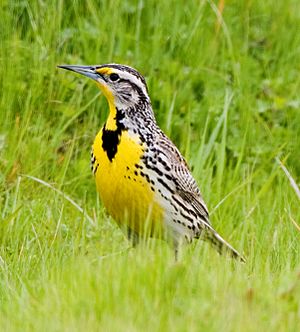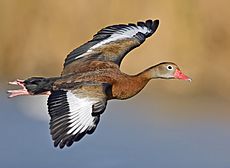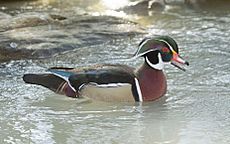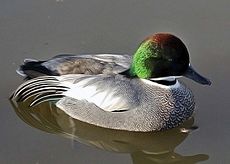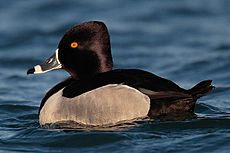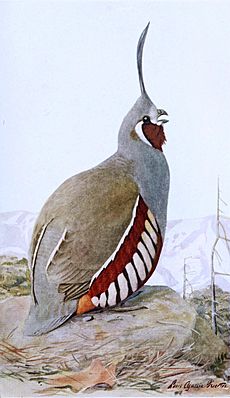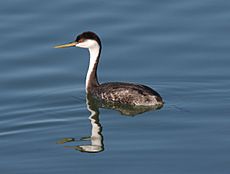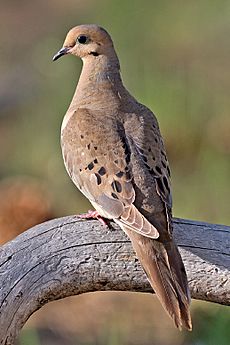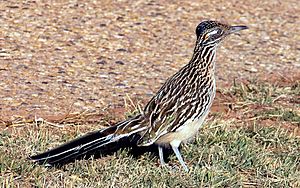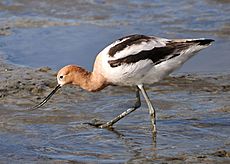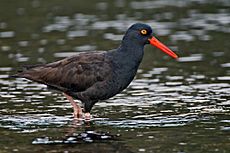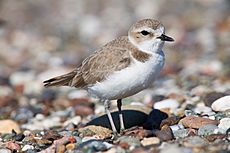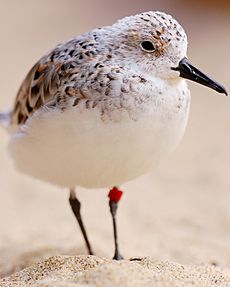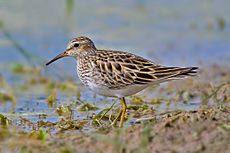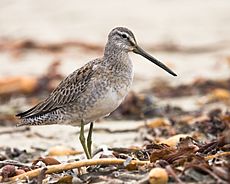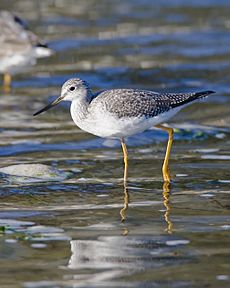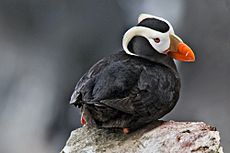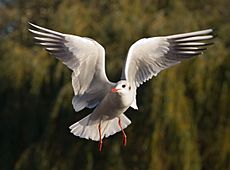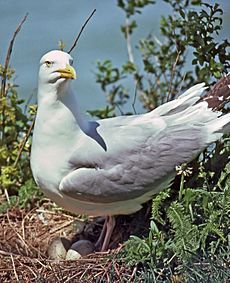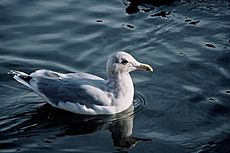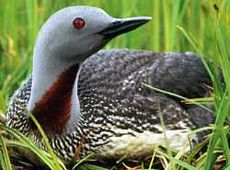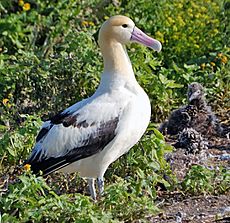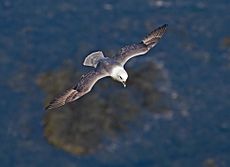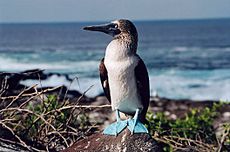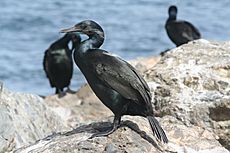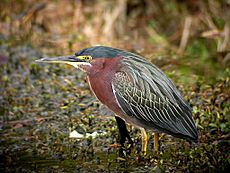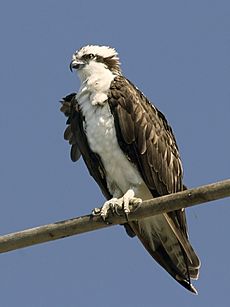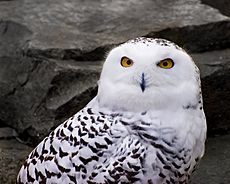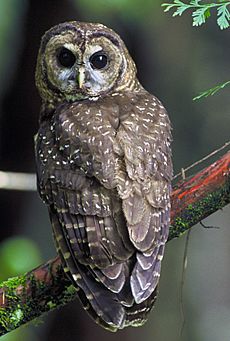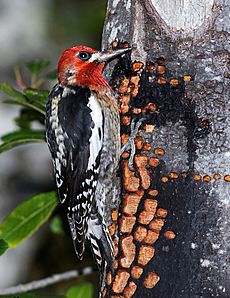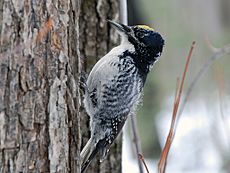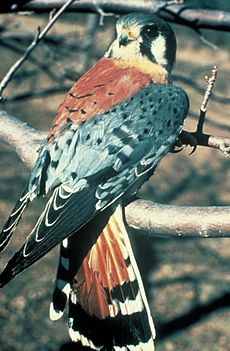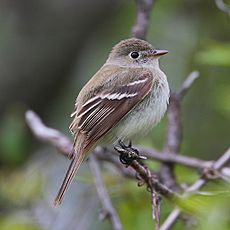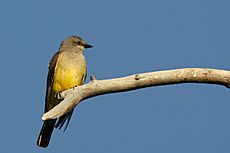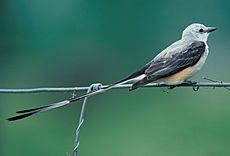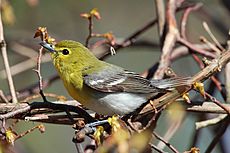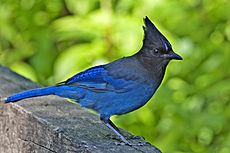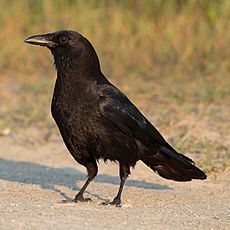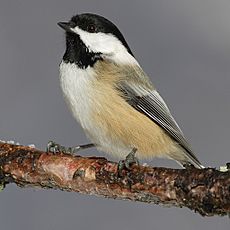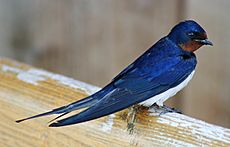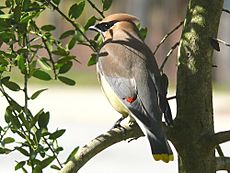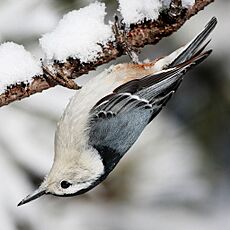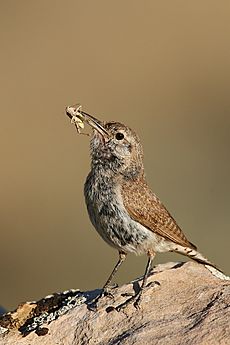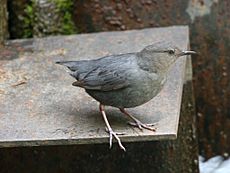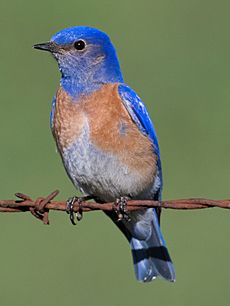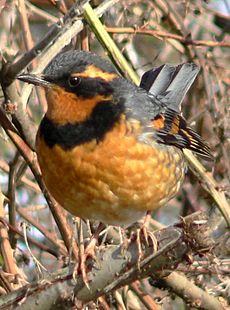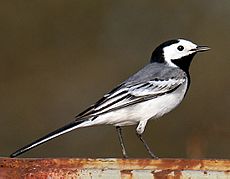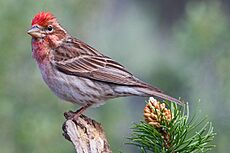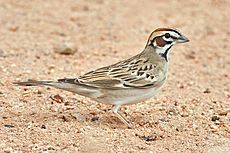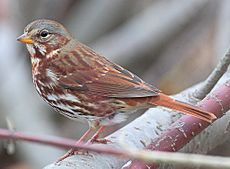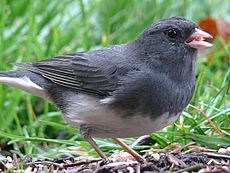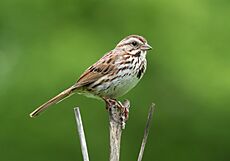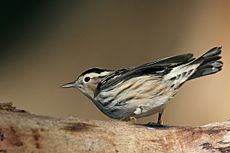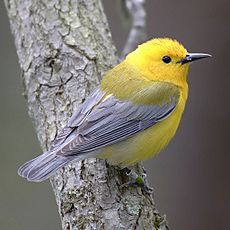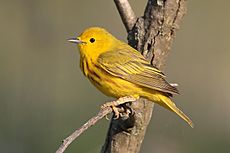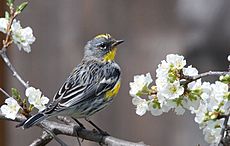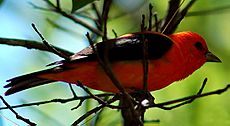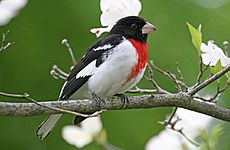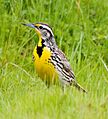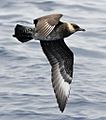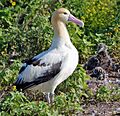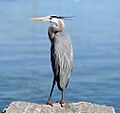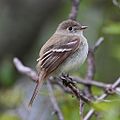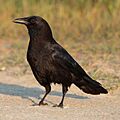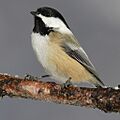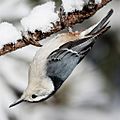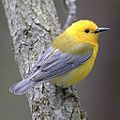List of birds of Oregon facts for kids
Oregon is a special place for birds! This article lists all the wild bird species that have been seen and officially recognized in the state of Oregon. As of August 2022, there are 547 different kinds of birds on this list.
Some birds are on a "review list." This means if someone sees them, they need to provide extra proof. A few species were brought to Oregon by people, and some of those, plus two others, have disappeared from the state.
Even though northern places usually have fewer types of birds, Oregon is actually fifth in the United States for bird variety! It has more bird species than many other states, like New Mexico and Texas. This is because Oregon has many different natural areas, like mountains, forests, and coasts. The mild winter weather also helps, making Oregon a key stopping point for birds that fly south for winter, especially ducks and geese, along a path called the Pacific Flyway.
Because Oregon is so important for birds, it has 120 special "Important Bird Areas." These are places like the Jackson Bottom Wetlands Preserve that are protected to help birds. Many of these wildlife refuges are popular spots for people who love to watch birds. Oregon has been part of organized bird-watching events, like the Christmas Bird Count, since the early 1900s. Other areas, like the Oregon Islands National Wildlife Refuge, are closed to people but are very popular with birds. This refuge stretches for about 250 miles (400 km) along the Oregon Coast.
Even with all these efforts, Oregon faces challenges in protecting birds that are endangered or threatened. Famous birds like the northern spotted owl and snowy plover are at risk. Even common birds, like Oregon's state bird, the western meadowlark, have seen their numbers drop. This is due to things like hunting and losing their natural homes.
This list follows the order used by the American Ornithological Society (AOS). The names of the birds and their families come from this list too.
You'll see some special notes next to certain birds:
- (R) Review list - These birds need more detailed proof if they are seen.
- (P) Provisional - This means the bird was only seen, with no video or sound proof.
- (I) Introduced - This bird was brought to Oregon by humans.
Contents
- Ducks, Geese, and Waterfowl
- New World Quail
- Pheasants, Grouse, and Allies
- Grebes
- Pigeons and Doves
- Cuckoos
- Nightjars and Allies
- Swifts
- Hummingbirds
- Rails, Gallinules, and Coots
- Cranes
- Stilts and Avocets
- Oystercatchers
- Plovers and Lapwings
- Sandpipers and Allies
- Skuas and Jaegers
- Auks, Murres, and Puffins
- Gulls, Terns, and Skimmers
- Tropicbirds
- Loons
- Albatrosses
- Southern Storm-Petrels
- Northern Storm-Petrels
- Shearwaters and Petrels
- Frigatebirds
- Boobies and Gannets
- Cormorants and Shags
- Pelicans
- Herons, Egrets, and Bitterns
- Ibises and Spoonbills
- New World Vultures
- Osprey
- Hawks, Eagles, and Kites
- Barn-Owls
- Owls
- Kingfishers
- Woodpeckers
- Falcons and Caracaras
- Tyrant Flycatchers
- Vireos, Shrike-Babblers, and Erpornis
- Shrikes
- Crows, Jays, and Magpies
- Tits, Chickadees, and Titmice
- Larks
- Swallows
- Long-tailed Tits
- Leaf Warblers
- Sylviid Warblers, Parrotbills, and Allies
- Kinglets
- Waxwings
- Silky-Flycatchers
- Nuthatches
- Treecreepers
- Gnatcatchers
- Wrens
- Mockingbirds and Thrashers
- Starlings
- Dippers
- Thrushes and Allies
- Old World Flycatchers
- Old World Sparrows
- Wagtails and Pipits
- Finches, Euphonias, and Allies
- Longspurs and Snow Buntings
- Old World Buntings
- New World Sparrows
- Yellow-breasted Chat
- Troupials and Allies
- New World Warblers
- Cardinals and Allies
- See also
- Images for kids
Ducks, Geese, and Waterfowl
Order: Anseriformes Family: Anatidae
This family includes ducks, geese, and swans. These birds are great in the water. They have webbed feet and special feathers that shed water easily.
- Black-bellied whistling-duck, Dendrocygna autumnalis (R)
- Fulvous whistling-duck, Dendrocygna bicolor (R)
- Emperor goose, Anser canagica
- Snow goose, Anser caerulescens
- Ross's goose, Anser rossii
- Greater white-fronted goose, Anser albifrons
- Tundra bean-goose, Anser serrirostris (R)
- Brant, Branta bernicla
- Cackling goose, Branta hutchinsii
- Canada goose, Branta canadensis
- Trumpeter swan, Cygnus buccinator
- Tundra swan, Cygnus columbianus
- Whooper swan, Cygnus cygnus (R)
- Wood duck, Aix sponsa
- Baikal teal, Sibirionetta formosa (R)
- Garganey, Sibirionetta querquedula (R)
- Blue-winged teal, Spatula discors
- Cinnamon teal, Spatula cyanoptera
- Northern shoveler, Spatula clypeata
- Gadwall, Mareca strepera
- Falcated duck, Mareca falcata (R)
- Eurasian wigeon, Mareca penelope
- American wigeon, Mareca americana
- American black duck, Anas rubripes (R)
- Mallard, Anas platyrhynchos
- Northern pintail, Anas acuta
- Green-winged teal, Anas crecca
- Canvasback, Aythya valisineria
- Redhead, Aythya americana
- Ring-necked duck, Aythya collaris
- Tufted duck, Aythya fuligula
- Greater scaup, Aythya marila
- Lesser scaup, Aythya affinis
- Steller's eider, Polysticta stelleri (R)
- King eider, Somateria spectabilis (R)
- Common eider, Somateria mollissima (R)
- Harlequin duck, Histrionicus histrionicus
- Surf scoter, Melanitta perspicillata
- White-winged scoter, Melanitta deglandi
- Common scoter, Melanitta nigra (R)
- Black scoter, Melanitta americana
- Long-tailed duck, Clangula hyemalis
- Bufflehead, Bucephala albeola
- Common goldeneye, Bucephala clangula
- Barrow's goldeneye, Bucephala islandica
- Smew, Mergellus albellus (R)
- Hooded merganser, Lophodytes cucullatus
- Common merganser, Mergus merganser
- Red-breasted merganser, Mergus serrator
- Ruddy duck, Oxyura jamaicensis
New World Quail
Order: Galliformes Family: Odontophoridae
New World quails are small, plump birds that live on the ground. They look like Old World quails but are not closely related.
- Mountain quail, Oreortyx pictus
- Northern bobwhite, Colinus virginianus (I)(extirpated)
- California quail, Callipepla californica
Pheasants, Grouse, and Allies
Order: Galliformes Family: Phasianidae
This family includes pheasants, partridges, grouse, and turkeys. They are ground-dwelling birds that vary in size. Many are hunted for food or raised on farms.
- Wild turkey, Meleagris gallopavo (I)
- Ruffed grouse, Bonasa umbellus
- Greater sage-grouse, Centrocercus urophasianus
- Spruce grouse, Canachites canadensis
- Dusky grouse, Dendragapus obscurus
- Sooty grouse, Dendragapus fuliginosus
- Sharp-tailed grouse, Tympanuchus phasianellus (R)(extirpated)
- Chukar, Alectoris chukar (I)
- Gray partridge, Perdix perdix (I)
- Ring-necked pheasant, Phasianus colchicus (I)
Grebes
Order: Podicipediformes Family: Podicipedidae
Grebes are small to medium-sized birds that dive in freshwater. They have special lobed toes that make them excellent swimmers. They are not very good at walking on land.
- Pied-billed grebe, Podilymbus podiceps
- Horned grebe, Podiceps auritus
- Red-necked grebe, Podiceps grisegena
- Eared grebe, Podiceps nigricollis
- Western grebe, Aechmophorus occidentalis
- Clark's grebe, Aechmophorus clarkii
Pigeons and Doves
Order: Columbiformes Family: Columbidae
Pigeons and doves are birds with plump bodies, short necks, and thin bills.
- Rock pigeon, Columba livia (I)
- Band-tailed pigeon, Patagioenas fasciata
- Eurasian collared-dove, Streptopelia decaocto (I)
- Common ground dove, Columbina passerina (R)
- White-winged dove, Zenaida asiatica
- Mourning dove, Zenaida macroura
Cuckoos
Order: Cuculiformes Family: Cuculidae
This family includes cuckoos and roadrunners. These birds have slender bodies, long tails, and strong legs.
- Greater roadrunner, Geococcyx californianus (R) (P)
- Yellow-billed cuckoo, Coccyzus americanus (R)
Nightjars and Allies
Order: Caprimulgiformes Family: Caprimulgidae
Nightjars are medium-sized birds that are active at night. They usually nest on the ground. They have long wings and short legs. Their soft feathers help them blend in with tree bark or leaves.
- Lesser nighthawk, Chordeiles acutipennis (R)
- Common nighthawk, Chordeiles minor
- Common poorwill, Phalaenoptilus nuttallii
- Eastern whip-poor-will, Antrostomus vociferus (R)
Swifts
Order: Apodiformes Family: Apodidae
Swifts are small birds that spend most of their lives flying. They have very short legs and usually perch only on vertical surfaces. Many swifts have long, swept-back wings.
- Black swift, Cypseloides niger
- Chimney swift, Chaetura pelagica (R)
- Vaux's swift, Chaetura vauxi
- White-throated swift, Aeronautes saxatalis
Hummingbirds
Order: Apodiformes Family: Trochilidae
Hummingbirds are tiny birds that can hover in the air by flapping their wings very fast. They are the only birds that can fly backward!
- Ruby-throated hummingbird, Archilochus colubris (R)
- Black-chinned hummingbird, Archilochus alexandri
- Anna's hummingbird, Calypte anna
- Costa's hummingbird, Calypte costae
- Calliope hummingbird, Selasphorus calliope
- Rufous hummingbird, Selasphorus rufus
- Allen's hummingbird, Selasphorus sasin
- Broad-tailed hummingbird, Selasphorus platycercus
- Broad-billed hummingbird, Cynanthus latirostris (R)
Rails, Gallinules, and Coots
Order: Gruiformes Family: Rallidae
This family includes rails, crakes, coots, and gallinules. They are small to medium-sized birds that live in thick plants near water. They are usually shy and hard to spot. Most have strong legs and long toes for walking on soft ground.
- Virginia rail, Rallus limicola
- Sora, Porzana carolina
- Common gallinule, Gallinula galeata (R)
- American coot, Fulica americana
- Yellow rail, Coturnicops noveboracensis
Cranes
Order: Gruiformes Family: Gruidae
Cranes are large birds with long legs and long necks. Unlike herons, cranes fly with their necks stretched out. Many cranes have loud and fancy courtship dances.
- Sandhill crane, Antigone canadensis
- Common crane, Grus grus (R)
Stilts and Avocets
Order: Charadriiformes Family: Recurvirostridae
This family includes avocets and stilts. Avocets have long legs and bills that curve upwards. Stilts have very long legs and long, thin, straight bills.
- Black-necked stilt, Himantopus mexicanus
- American avocet, Recurvirostra americana
Oystercatchers
Order: Charadriiformes Family: Haematopodidae
Oystercatchers are large, easy-to-spot, and noisy birds. They have strong bills that they use to open molluscs like clams.
- Black oystercatcher, Haematopus bachmani
Plovers and Lapwings
Order: Charadriiformes Family: Charadriidae
This family includes plovers and lapwings. They are small to medium-sized birds with compact bodies and short, thick necks. They live in open areas around the world, usually near water.
- Black-bellied plover, Pluvialis squatarola
- American golden-plover, Pluvialis dominica
- Pacific golden-plover, Pluvialis fulva
- Eurasian dotterel, Charadrius morinellus (R)
- Killdeer, Charadrius vociferus
- Semipalmated plover, Charadrius semipalmatus
- Piping plover, Charadrius melodus (R) (P)
- Lesser sand-plover, Charadrius mongolus (R)
- Wilson's plover, Charadrius wilsonia (R)
- Snowy plover, Charadrius nivosus
- Mountain plover, Charadrius montanus (R)
Sandpipers and Allies
Order: Charadriiformes Family: Scolopacidae
This is a large family of small to medium-sized shorebirds. It includes sandpipers, curlews, and snipes. Most of these birds eat small bugs they find in mud or soil. Different bill and leg lengths allow many species to feed in the same area without competing for food.
- Upland sandpiper, Bartramia longicauda (R)
- Bristle-thighed curlew, Numenius tahitiensis (R)
- Whimbrel, Numenius phaeopus
- Long-billed curlew, Numenius americanus
- Bar-tailed godwit, Limosa lapponica (R)
- Hudsonian godwit, Limosa haemastica (R)
- Marbled godwit, Limosa fedoa
- Ruddy turnstone, Arenaria interpres
- Black turnstone, Arenaria melanocephala
- Great knot, Calidris tenuirostris (R)
- Red knot, Calidris canutus
- Surfbird, Calidris virgata
- Ruff, Calidris pugnax
- Sharp-tailed sandpiper, Calidris acuminata
- Stilt sandpiper, Calidris himantopus
- Curlew sandpiper, Calidris ferruginea (R)
- Long-toed stint, Calidris subminuta (R)
- Red-necked stint, Calidris ruficollis (R)
- Sanderling, Calidris alba
- Dunlin, Calidris alpina
- Rock sandpiper, Calidris ptilocnemis
- Baird's sandpiper, Calidris bairdii
- Little stint, Calidris minuta (R)
- Least sandpiper, Calidris minutilla
- White-rumped sandpiper, Calidris fuscicollis (R)
- Buff-breasted sandpiper, Calidris subruficollis
- Pectoral sandpiper, Calidris melanotos
- Semipalmated sandpiper, Calidris pusilla
- Western sandpiper, Calidris mauri
- Short-billed dowitcher, Limnodromus griseus
- Long-billed dowitcher, Limnodromus scolopaceus
- Jack snipe, Lymnocryptes minimus (R)
- Wilson's snipe, Gallinago delicata
- Spotted sandpiper, Actitis macularius
- Solitary sandpiper, Tringa solitaria
- Wandering tattler, Tringa incanus
- Lesser yellowlegs, Tringa flavipes
- Willet, Tringa semipalmata
- Spotted redshank, Tringa erythropus (R)
- Greater yellowlegs, Tringa melanoleuca
- Wood sandpiper, Tringa glareola (R)
- Wilson's phalarope, Phalaropus tricolor
- Red-necked phalarope, Phalaropus lobatus
- Red phalarope, Phalaropus fulicarius
Skuas and Jaegers
Order: Charadriiformes Family: Stercorariidae
Skuas and jaegers are medium to large birds, usually gray or brown. They look like big, dark gulls. They are strong, skilled flyers.
- South polar skua, Stercorarius maccormicki
- Pomarine jaeger, Stercorarius pomarinus
- Parasitic jaeger, Stercorarius parasiticus
- Long-tailed jaeger, Stercorarius longicaudus
Auks, Murres, and Puffins
Order: Charadriiformes Family: Alcidae
Alcids look a bit like penguins because they are black and white and stand upright. But unlike penguins, they can fly! Auks live in the open ocean and only come to land to nest.
- Common murre, Uria aalge
- Thick-billed murre, Uria lomvia (R)
- Pigeon guillemot, Cepphus columba
- Long-billed murrelet, Brachyramphus perdix (R)
- Marbled murrelet, Brachyramphus marmoratus
- Scripps's murrelet, Synthliboramphus scrippsi
- Guadalupe murrelet, Synthliboramphus hypoleucus (R)
- Ancient murrelet, Synthliboramphus antiquus
- Cassin's auklet, Ptychoramphus aleuticus
- Parakeet auklet, Aethia psittacula
- Rhinoceros auklet, Cerorhinca monocerata
- Horned puffin, Fratercula corniculata
- Tufted puffin, Fratercula cirrhata
Gulls, Terns, and Skimmers
Order: Charadriiformes Family: Laridae
This family includes gulls and terns. They are medium to large seabirds, usually gray or white with black markings. They have strong bills and webbed feet.
- Black-legged kittiwake, Rissa tridactyla
- Red-legged kittiwake, Rissa brevirostris (R)
- Sabine's gull, Xema sabini
- Bonaparte's gull, Chroicocephalus philadelphia
- Black-headed gull, Chroicocephalus ridibundus (R)
- Little gull, Hydrocoloeus minutus (R)
- Ross's gull, Rhodostethia rosea (R)
- Laughing gull, Leucophaeus atricilla (R)
- Franklin's gull, Leucophaeus pipixcan
- Heermann's gull, Larus heermanni
- Short-billed gull, Larus brachyrhynchus
- Ring-billed gull, Larus delawarensis
- Western gull, Larus occidentalis
- California gull, Larus californicus
- Herring gull, Larus argentatus
- Iceland gull, Larus glaucoides
- Lesser black-backed gull, Larus fuscus (R)
- Slaty-backed gull, Larus schistisagus (R)
- Glaucous-winged gull, Larus glaucescens
- Glaucous gull, Larus hyperboreus
- Least tern, Sternula antillarum (R)
- Caspian tern, Hydroprogne caspia
- Black tern, Chlidonias niger
- Common tern, Sterna hirundo
- Arctic tern, Sterna paradisaea
- Forster's tern, Sterna forsteri
- Elegant tern, Thalasseus elegans
- Black skimmer, Rynchops niger (R) (P)
Tropicbirds
Order: Phaethontiformes Family: Phaethontidae
Tropicbirds are thin, white birds found in tropical oceans. They have very long central tail feathers. Their wings and heads have black markings.
- Red-billed tropicbird, Phaethon aethereus (R)
Loons
Order: Gaviiformes Family: Gaviidae
Loons are water birds, about the size of a large duck. They are mostly gray or black with spear-shaped bills. Loons swim and fly well, but they are clumsy on land because their legs are at the back of their bodies.
- Red-throated loon, Gavia stellata
- Arctic loon, Gavia arctica (R)
- Pacific loon, Gavia pacifica
- Common loon, Gavia immer
- Yellow-billed loon, Gavia adamsii
Albatrosses
Order: Procellariiformes Family: Diomedeidae
Albatrosses are among the largest flying birds. Some, like the great albatrosses, have the biggest wingspans of any living bird.
- White-capped albatross, Thalassarche cauta (R)
- Wandering albatross, Diomedea exulans (R)
- Laysan albatross, Phoebastria immutabilis
- Black-footed albatross, Phoebastria nigripes
- Short-tailed albatross, Phoebastria albatrus (R)
Southern Storm-Petrels
Order: Procellariiformes Family: Oceanitidae
Storm-petrels are the smallest seabirds. They are related to petrels and eat tiny ocean creatures. They often hover over the water to pick up food.
- Wilson's storm-petrel, Oceanites oceanicus (R)
Northern Storm-Petrels
Order: Procellariiformes Family: Hydrobatidae
These storm-petrels look and act like Southern storm-petrels. However, they have enough genetic differences to be in their own family.
- Fork-tailed storm-petrel, Hydrobates furcatus
- Leach's storm-petrel, Hydrobates leucorhous
- Ashy storm-petrel, Hydrobates homochroa (R)
- Black storm-petrel, Hydrobates melania (R)
Shearwaters and Petrels
Order: Procellariiformes Family: Procellariidae
This group includes medium-sized "true petrels." They are known for their strong outer wing feathers.
- Northern fulmar, Fulmarus glacialis
- Murphy's petrel, Pterodroma ultima
- Mottled petrel, Pterodroma inexpectata
- Juan Fernandez petrel, Pterodroma externa (R) (P)
- Hawaiian petrel, Pterodroma sandwichensis
- Cook's petrel, Pterodroma cookii (R)
- Stejneger's petrel, Pterodroma longirostris (R) (P)
- Streaked shearwater, Calonectris leucomelas (R) (P)
- Wedge-tailed shearwater, Ardenna pacificus (R)
- Buller's shearwater, Ardenna bulleri
- Short-tailed shearwater, Ardenna tenuirostris
- Sooty shearwater, Ardenna griseus
- Great shearwater, Ardenna gravis (R)
- Pink-footed shearwater, Ardenna creatopus
- Flesh-footed shearwater, Ardenna carneipes
- Manx shearwater, Puffinus puffinus
- Black-vented shearwater, Puffinus opisthomelas (R) (P)
Frigatebirds
Order: Suliformes Family: Fregatidae
Frigatebirds are large seabirds found in tropical oceans. They are mostly black with long wings and deeply forked tails. Males have colorful throat pouches that they can inflate. They are amazing flyers and can stay in the air for over a week!
- Magnificent frigatebird, Fregata magnificens (R)
Boobies and Gannets
Order: Suliformes Family: Sulidae
This family includes gannets and boobies. Both are medium to large coastal seabirds. They dive headfirst into the water to catch fish.
- Masked booby, Sula dactylatra (R)
- Nazca booby, Sula granti (R)
- Blue-footed booby, Sula nebouxii (R)
- Brown booby, Sula leucogaster (R)
- Red-footed booby, Sula sula (R)
Cormorants and Shags
Order: Suliformes Family: Phalacrocoracidae
Cormorants are medium to large water birds. They usually have dark feathers and colored skin on their faces. Their bills are long, thin, and hooked. They have webbed feet with four toes.
- Brandt's cormorant, Urile penicillatus
- Pelagic cormorant, Nannopterum auritum
- Double-crested cormorant, Nannopterum brasilianum
Pelicans
Order: Pelecaniformes Family: Pelecanidae
Pelicans are very large water birds. They have a special pouch under their beak to scoop up fish. Like other birds in their group, they have four webbed toes.
- American white pelican, Pelecanus erythrorhynchos
- Brown pelican, Pelecanus occidentalis
Herons, Egrets, and Bitterns
Order: Pelecaniformes Family: Ardeidae
This family includes herons, egrets, and bitterns. Herons and egrets are medium to large wading birds with long necks and legs. Bitterns are usually shorter-necked and more hidden. These birds fly with their necks pulled back, unlike storks or ibises.
- American bittern, Botaurus lentiginosus
- Least bittern, Ixobrychus exilis (R)
- Great blue heron, Ardea herodias
- Great egret, Ardea alba
- Snowy egret, Egretta thula
- Little blue heron, Egretta caerulea (R)
- Tricolored heron, Egretta tricolor (R)
- Cattle egret, Bubulcus ibis
- Green heron, Butorides virescens
- Black-crowned night-heron, Nycticorax nycticorax
- Yellow-crowned night-heron, Nyctanassa violacea (R)
Ibises and Spoonbills
Order: Pelecaniformes Family: Threskiornithidae
This family includes ibises and spoonbills. They have long, wide wings and long bodies with long legs. Ibises have bills that curve downwards, while spoonbills have straight, flattened bills.
- White ibis, Eudocimus albus (R)
- Glossy ibis, Plegadis falcinellus (R)
- White-faced ibis, Plegadis chihi
New World Vultures
Order: Cathartiformes Family: Cathartidae
New World vultures are not closely related to Old World vultures. However, they look similar because they evolved in similar ways. Like Old World vultures, they eat dead animals. But New World vultures can smell dead animals, while Old World vultures find them by sight.
- California condor, Gymnogyps californianus (R) extirpated
- Black vulture, Coragyps atratus (R)
- Turkey vulture, Cathartes aura
Osprey
Order: Accipitriformes Family: Pandionidae
The Osprey is the only bird in its family. It is a fish-eating bird of prey. It has a very large, hooked beak, strong legs, powerful talons, and excellent eyesight.
- Osprey, Pandion haliaetus
Hawks, Eagles, and Kites
Order: Accipitriformes Family: Accipitridae
This family includes hawks, eagles, and harriers. These birds of prey have very large, hooked beaks to tear meat from their prey. They also have strong legs, powerful talons, and sharp eyesight.
- White-tailed kite, Elanus leucurus
- Golden eagle, Aquila chrysaetos
- Northern harrier, Circus hudsonius
- Sharp-shinned hawk, Accipiter striatus
- Cooper's hawk, Accipiter cooperii
- American goshawk, Accipiter atricapillus
- Bald eagle, Haliaeetus leucocephalus
- Red-shouldered hawk, Buteo lineatus
- Broad-winged hawk, Buteo platypterus
- Swainson's hawk, Buteo swainsoni
- Zone-tailed hawk, Buteo albonotatus (R)
- Red-tailed hawk, Buteo jamaicensis
- Rough-legged hawk, Buteo lagopus
- Ferruginous hawk, Buteo regalis
Barn-Owls
Order: Strigiformes Family: Tytonidae
Barn-owls are medium to large owls with big heads and heart-shaped faces. They have long, strong legs with powerful talons.
- Barn owl, Tyto alba
Owls
Order: Strigiformes Family: Strigidae
Typical owls are mostly solitary birds of prey that are active at night. They have large eyes that face forward and good hearing. They also have a hawk-like beak and a circle of feathers around each eye.
- Flammulated owl, Psiloscops flammeolus
- Western screech-owl, Megascops kennicottii
- Great horned owl, Bubo virginianus
- Snowy owl, Bubo scandiacus
- Northern hawk owl, Surnia ulula (R)
- Northern pygmy-owl, Glaucidium gnoma
- Burrowing owl, Athene cunicularia
- Spotted owl, Strix occidentalis
- Barred owl, Strix varia
- Great gray owl, Strix nebulosa
- Long-eared owl, Asio otus
- Short-eared owl, Asio flammeus
- Boreal owl, Aegolius funereus
- Northern saw-whet owl, Aegolius acadicus
Kingfishers
Order: Coraciiformes Family: Alcedinidae
Kingfishers are medium-sized birds. They have large heads, long pointed bills, short legs, and stubby tails.
- Belted kingfisher, Megaceryle alcyon
Woodpeckers
Order: Piciformes Family: Picidae
Woodpeckers are small to medium-sized birds. They have chisel-like beaks, short legs, and stiff tails. They use their long tongues to catch insects. Many woodpeckers tap loudly on tree trunks with their beaks.
- Lewis's woodpecker, Melanerpes lewis
- Red-headed woodpecker, Melanerpes erythrocephalus (R)
- Acorn woodpecker, Melanerpes formicivorus
- Red-bellied woodpecker, Melanerpes carolinus (R)
- Williamson's sapsucker, Sphyrapicus thyroideus
- Yellow-bellied sapsucker, Sphyrapicus varius
- Red-naped sapsucker, Sphyrapicus nuchalis
- Red-breasted sapsucker, Sphyrapicus ruber
- American three-toed woodpecker, Picoides dorsalis
- Black-backed woodpecker, Picoides arcticus
- Downy woodpecker, Dryobates pubescens
- Nuttall's woodpecker, Dryobates nuttallii (R)
- Hairy woodpecker, Dryobates villosus
- White-headed woodpecker, Dryobates albolarvatus
- Northern flicker, Colaptes auratus
- Pileated woodpecker, Dryocopus pileatus
Falcons and Caracaras
Order: Falconiformes Family: Falconidae
This family includes falcons and caracaras. They are birds of prey that are active during the day. Unlike hawks, they kill their prey with their beaks instead of their talons.
- Crested caracara, Caracara plancus (R)
- American kestrel, Falco sparverius
- Merlin, Falco columbarius
- Gyrfalcon, Falco rusticolus
- Peregrine falcon, Falco peregrinus
- Prairie falcon, Falco mexicanus
Tyrant Flycatchers
Order: Passeriformes Family: Tyrannidae
Tyrant flycatchers are songbirds found in North and South America. They look a bit like Old World flycatchers but are stronger. Most of them eat insects.
- Dusky-capped flycatcher, Myiarchus tuberculifer (R)
- Ash-throated flycatcher, Myiarchus cinerascens
- Great crested flycatcher, Myiarchus crinitus (R)
- Tropical kingbird, Tyrannus melancholicus
- Cassin's kingbird, Tyrannus vociferans (R)
- Western kingbird, Tyrannus verticalis
- Eastern kingbird, Tyrannus tyrannus
- Scissor-tailed flycatcher, Tyrannus forficatus (R)
- Olive-sided flycatcher, Contopus cooperi
- Western wood-pewee, Contopus sordidulus
- Eastern wood-pewee, Contopus virens (R)
- Yellow-bellied flycatcher, Empidonax flaviventris (R)
- Alder flycatcher, Empidonax alnorum (R)
- Willow flycatcher, Empidonax traillii
- Least flycatcher, Empidonax minimus
- Hammond's flycatcher, Empidonax hammondii
- Gray flycatcher, Empidonax wrightii
- Dusky flycatcher, Empidonax oberholseri
- Western flycatcher, Empidonax difficilis
- Black phoebe, Sayornis nigricans
- Eastern phoebe, Sayornis phoebe (R)
- Say's phoebe, Sayornis saya
- Vermilion flycatcher, Pyrocephalus rubinus (R)
Vireos, Shrike-Babblers, and Erpornis
Order: Passeriformes Family: Vireonidae
Vireos are small to medium-sized songbirds mostly found in the New World. They are usually greenish and look like wood-warblers, but have stronger bills.
- White-eyed vireo, Vireo griseus (R)
- Bell's vireo, Vireo bellii (R) (P)
- Hutton's vireo, Vireo huttoni
- Yellow-throated vireo, Vireo flavifrons (R)
- Cassin's vireo, Vireo cassinii
- Blue-headed vireo, Vireo solitarius (R)
- Plumbeous vireo, Vireo plumbeus (R)
- Philadelphia vireo, Vireo philadelphicus (R)
- Warbling vireo, Vireo gilvus
- Red-eyed vireo, Vireo olivaceus
Shrikes
Order: Passeriformes Family: Laniidae
Shrikes are songbirds known for catching small animals and impaling them on thorns. Their beaks are hooked, like a bird of prey.
- Loggerhead shrike, Lanius ludovicianus
- Northern shrike, Lanius borealis
Crows, Jays, and Magpies
Order: Passeriformes Family: Corvidae
This family includes crows, ravens, jays, and magpies. Corvids are larger than average songbirds. Some of the bigger species are very intelligent.
- Canada jay, Perisoreus canadensis
- Pinyon jay, Gymnorhinus cyanocephalus
- Steller's jay, Cyanocitta stelleri
- Blue jay, Cyanocitta cristata
- California scrub-jay, Aphelocoma californica
- Woodhouse's scrub-jay, Aphelocoma woodhouseii
- Clark's nutcracker, Nucifraga columbiana
- Black-billed magpie, Pica hudsonia
- American crow, Corvus brachyrhynchos
- Common raven, Corvus corax
Tits, Chickadees, and Titmice
Order: Passeriformes Family: Paridae
This family includes small, stocky woodland birds with short, strong bills. They are adaptable and eat both seeds and insects.
- Black-capped chickadee, Poecile atricapillus
- Mountain chickadee, Poecile gambeli
- Chestnut-backed chickadee, Poecile rufescens
- Oak titmouse, Baeolophus inornatus
- Juniper titmouse, Baeolophus ridgwayi
Larks
Order: Passeriformes Family: Alaudidae
Larks are small ground birds known for their fancy songs and display flights. Most larks are plain-looking. They eat insects and seeds.
- Eurasian skylark, Alauda arvensis (R)
- Horned lark, Eremophila alpestris
Swallows
Order: Passeriformes Family: Hirundinidae
This family of birds is built for catching food while flying. They have slender bodies, long pointed wings, and short bills with wide mouths. Their feet are better for perching than walking.
- Bank swallow, Riparia riparia
- Tree swallow, Tachycineta bicolor
- Violet-green swallow, Tachycineta thalassina
- Northern rough-winged swallow, Stelgidopteryx serripennis
- Purple martin, Progne subis
- Barn swallow, Hirundo rustica
- Cliff swallow, Petrochelidon pyrrhonota
- Cave swallow, Petrochelidon fulva (R)
Long-tailed Tits
Order: Passeriformes Family: Aegithalidae
Long-tailed tits are a family of small songbirds with medium to long tails. They build woven, bag-shaped nests in trees. Most eat a mix of insects.
- Bushtit, Psaltriparus minimus
Leaf Warblers
Order: Passeriformes Family: Phylloscopidae
Leaf warblers are a family of small insect-eating birds. They are mostly found in Europe and Asia. They come in different sizes and are often green above and yellow below.
- Dusky warbler, Phylloscopus fuscatus (R)
- Arctic warbler, Phylloscopus borealis (R)
Sylviid Warblers, Parrotbills, and Allies
Order: Passeriformes Family: Sylviidae
This family is a group of small insect-eating songbirds. They are mainly found in Europe, Asia, and Africa. Most are plain-looking but have unique songs.
- Wrentit, Chamaea fasciata
Kinglets
Order: Passeriformes Family: Regulidae
Kinglets are a small family of birds that look like titmice. They are very small insect-eating birds. Adult kinglets have colorful crowns on their heads.
- Ruby-crowned kinglet, Corphylio calendula
- Golden-crowned kinglet, Regulus satrapa
Waxwings
Order: Passeriformes Family: Bombycillidae
Waxwings have soft, silky feathers. They have unique red tips on some of their wing feathers that look like sealing wax. These birds live in northern forests. They eat insects in summer and berries in winter.
- Bohemian waxwing, Bombycilla garrulus
- Cedar waxwing, Bombycilla cedrorum
Silky-Flycatchers
Order: Passeriformes Family: Ptiliogonatidae
Silky-flycatchers are a small family of songbirds mostly found in Central America. They are related to waxwings and most have small crests on their heads.
- Phainopepla, Phainopepla nitens (R)
Nuthatches
Order: Passeriformes Family: Sittidae
Nuthatches are small woodland birds. They have a special ability to climb down trees headfirst, unlike most other birds. Nuthatches have big heads, short tails, and strong bills and feet.
- Red-breasted nuthatch, Sitta canadensis
- White-breasted nuthatch, Sitta carolinensis
- Pygmy nuthatch, Sitta pygmaea
Treecreepers
Order: Passeriformes Family: Certhiidae
Treecreepers are small woodland birds, brown on top and white underneath. They have thin, curved bills that they use to pull insects from tree bark. Their stiff tail feathers help them support themselves on vertical trees.
- Brown creeper, Certhia americana
Gnatcatchers
Order: Passeriformes Family: Polioptilidae
These delicate birds look and act like Old World warblers. They move quickly through leaves looking for insects. Gnatcatchers are usually soft bluish-gray and have long, sharp bills. Many have black patterns on their heads and long, black-and-white tails that they often hold up.
- Blue-gray gnatcatcher, Polioptila caerulea
Wrens
Order: Passeriformes Family: Troglodytidae
Wrens are small and often hard to see, but they have very loud songs. They have short wings and thin, curved bills. Several species often hold their tails straight up. All wrens eat insects.
- Rock wren, Salpinctes obsoletus
- Canyon wren, Catherpes mexicanus
- House wren, Troglodytes aedon
- Pacific wren, Troglodytes pacificus
- Winter wren, Troglodytes hiemalis (R)
- Sedge wren, Cistothorus platensis (R)
- Marsh wren, Cistothorus palustris
- Bewick's wren, Thryomanes bewickii
Mockingbirds and Thrashers
Order: Passeriformes Family: Mimidae
This family includes thrashers and mockingbirds. These birds are famous for their amazing songs and their ability to copy many different bird calls and other sounds. They usually have dull gray and brown feathers.
- Gray catbird, Dumetella carolinensis
- Curve-billed thrasher, Toxostoma curvirostre (R) (P)
- Brown thrasher, Toxostoma rufum
- California thrasher, Toxostoma redivivum (R)
- Sage thrasher, Oreoscoptes montanus
- Northern mockingbird, Mimus polyglottos
Starlings
Order: Passeriformes Family: Sturnidae
Starlings are small to medium-sized Old World songbirds with strong feet. They fly strongly and directly, and most live in large groups. They prefer open areas and eat insects and fruit. Many species have dark feathers with a shiny, metallic look.
- European starling, Sturnus vulgaris (I)
Dippers
Order: Passeriformes Family: Cinclidae
Dippers are a group of songbirds that live near water in the Americas, Europe, and Asia. They are named for their bobbing or dipping movements. These birds can go underwater and walk on the bottom to find insect larvae to eat.
- American dipper, Cinclus mexicanus
Thrushes and Allies
Order: Passeriformes Family: Turdidae
Thrushes are a group of songbirds, mostly found in the Old World. They are plump, soft-feathered, and small to medium-sized. They eat insects or sometimes everything, often finding food on the ground. Many have beautiful songs.
- Eastern bluebird, Sialia sialis (R)
- Western bluebird, Sialia mexicana
- Mountain bluebird, Sialia currucoides
- Townsend's solitaire, Myadestes townsendi
- Veery, Catharus fuscescens
- Gray-cheeked thrush, Catharus minimus (R)
- Swainson's thrush, Catharus ustulatus
- Hermit thrush, Catharus guttatus
- Wood thrush, Hylocichla mustelina (R)
- Dusky thrush, Turdus naumanni (R)
- American robin, Turdus migratorius
- Varied thrush, Ixoreus naevius
Old World Flycatchers
Order: Passeriformes Family: Muscicapidae
Old World flycatchers are a large family of small songbirds. These are mainly small birds that live in trees and eat insects. Many catch their prey while flying.
- Red-flanked bluetail, Tarsiger cyanurus (R)
- Northern wheatear, Oenanthe oenanthe (R)
Old World Sparrows
Order: Passeriformes Family: Passeridae
Old World sparrows are small songbirds. They are usually small, plump, brownish or grayish birds with short tails and strong beaks. Sparrows eat seeds, but they also eat small insects.
- House sparrow, Passer domesticus (I)
Wagtails and Pipits
Order: Passeriformes Family: Motacillidae
This family includes wagtails and pipits. They are small songbirds with medium to long tails. They are thin, ground-feeding insect-eaters found in open areas.
- Eastern yellow wagtail, Motacilla tschutschensis (R)
- White wagtail, Montacilla alba (R)
- Red-throated pipit, Anthus cervinus (R)
- American pipit, Anthus rubescens
- Sprague's pipit, Anthus spragueii (R)
Finches, Euphonias, and Allies
Order: Passeriformes Family: Fringillidae
Finches are seed-eating songbirds. They are small to medium-sized and have strong, often cone-shaped beaks. They have a bouncy flight pattern, flapping and then gliding with closed wings. Most finches sing well.
- Brambling, Fringilla montifringilla (R)
- Evening grosbeak, Coccothraustes vespertinus
- Pine grosbeak, Pinicola enucleator
- Gray-crowned rosy-finch, Leucosticte tephrocotis
- Black rosy-finch, Leucosticte atrata
- House finch, Haemorhous mexicanus
- Purple finch, Haemorhous purpureus
- Cassin's finch, Haemorhous cassinii
- Oriental greenfinch, Chloris sinica (R)
- Common redpoll, Acanthis flammea
- Hoary redpoll, Acanthis hornemanni (R)
- Red crossbill, Loxia curvirostra
- White-winged crossbill, Loxia leucoptera
- Pine siskin, Spinus pinus
- Lesser goldfinch, Spinus psaltria
- Lawrence's goldfinch, Spinus lawrencei (R)
- American goldfinch, Spinus tristis
Longspurs and Snow Buntings
Order: Passeriformes Family: Calcariidae
This group of songbirds used to be part of the New World sparrows. They are usually found in open grassy areas.
- Lapland longspur, Calcarius lapponicus
- Chestnut-collared longspur, Calcarius ornatus
- Smith's longspur, Calcarius pictus (R)
- Thick-billed longspur, Rhynchophanes mccownii (R)
- Snow bunting, Plectrophenax nivalis
- McKay's bunting, Plectrophenax hyperboreus (R)
Old World Buntings
Order: Passeriformes Family: Emberizidae
This family of songbirds contains only one group of birds. Until 2017, the New World sparrows were also considered part of this family.
- Little bunting, Emberiza pusilla (R)
- Rustic bunting, Emberiza rustica (R)
New World Sparrows
Order: Passeriformes Family: Passerellidae
These birds were once part of the Emberizidae family. Most are called sparrows, but they are not closely related to the Old World sparrows. Many of these birds have unique patterns on their heads.
- Cassin's sparrow, Peucaea cassinii (R)
- Grasshopper sparrow, Ammodramus savannarum
- Black-throated sparrow, Amphispiza bilineata
- Lark sparrow, Chondestes grammacus
- Lark bunting, Calamospiza melanocorys
- Chipping sparrow, Spizella passerina
- Clay-colored sparrow, Spizella pallida
- Black-chinned sparrow, Spizella atrogularis (R)
- Brewer's sparrow, Spizella breweri
- Fox sparrow, Passerella iliaca
- American tree sparrow, Spizelloides arborea
- Dark-eyed junco, Junco hyemalis
- White-crowned sparrow, Zonotrichia leucophrys
- Golden-crowned sparrow, Zonotrichia atricapilla
- Harris's sparrow, Zonotrichia querula
- White-throated sparrow, Zonotrichia albicollis
- Sagebrush sparrow, Artemisiospiza nevadensis
- Vesper sparrow, Pooecetes gramineus
- LeConte's sparrow, Ammospiza leconteii (R)
- Savannah sparrow, Passerculus sandwichensis
- Song sparrow, Melospiza melodia
- Lincoln's sparrow, Melospiza lincolnii
- Swamp sparrow, Melospiza georgiana
- California towhee, Melozone crissalis
- Green-tailed towhee, Pipilo chlorurus
- Spotted towhee, Pipilo maculatus
- Eastern towhee, Pipilo erythrophthalmus (R)
Yellow-breasted Chat
Order: Passeriformes Family: Icteriidae
This bird was once thought to be a wood-warbler, but experts decided it needed its own family in 2017.
- Yellow-breasted chat, Icteria virens
Troupials and Allies
Order: Passeriformes Family: Icteridae
This group includes grackles and New World blackbirds and orioles. They are small to medium-sized, often colorful songbirds found only in the New World. Most species are mainly black, sometimes with bright yellow, orange, or red colors.
- Yellow-headed blackbird, Xanthocephalus xanthocephalus
- Bobolink, Dolichonyx oryzivorus
- Western meadowlark, Sturnella neglecta
- Orchard oriole, Icterus spurius (R)
- Hooded oriole, Icterus cucullatus
- Streak-backed oriole, Icterus pustulatus (R)
- Bullock's oriole, Icterus bullockii
- Baltimore oriole, Icterus galbula (R)
- Scott's oriole, Icterus parisorum (R)
- Red-winged blackbird, Agelaius phoeniceus
- Tricolored blackbird, Agelaius tricolor
- Brown-headed cowbird, Molothrus ater
- Rusty blackbird, Euphagus carolinus
- Brewer's blackbird, Euphagus cyanocephalus
- Common grackle, Quiscalus quiscula (R)
- Great-tailed grackle, Quiscalus mexicanus
New World Warblers
Order: Passeriformes Family: Parulidae
Wood warblers are a group of small, often colorful songbirds found only in the New World. Most live in trees, but some spend more time on the ground. Most birds in this family eat insects.
- Ovenbird, Seiurus aurocapilla
- Worm-eating warbler, Helmitheros vermivorum (R) (P)
- Louisiana waterthrush, Parkesia motacilla (R)
- Northern waterthrush, Parkesia noveboracensis
- Golden-winged warbler, Vermivora chrysoptera (R)
- Blue-winged warbler, Vermivora cyanoptera (R)
- Black-and-white warbler, Mniotilta varia
- Prothonotary warbler, Protonotaria citrea (R)
- Tennessee warbler, Leiothlypis peregrina
- Orange-crowned warbler, Leiothlypis celata
- Lucy's warbler, Leiothlypis luciae (R)
- Nashville warbler, Leiothlypis ruficapilla
- Virginia's warbler, Leiothlypis virginiae (R)
- MacGillivray's warbler, Geothlypis tolmiei
- Mourning warbler, Geothlypis philadelphia (R)
- Kentucky warbler, Geothlypis formosa (R)
- Common yellowthroat, Geothlypis trichas
- Hooded warbler, Setophaga citrina (R)
- American redstart, Setophaga ruticilla
- Cape May warbler, Setophaga tigrina (R)
- Northern parula, Setophaga americana
- Magnolia warbler, Setophaga magnolia
- Bay-breasted warbler, Setophaga castanea (R)
- Blackburnian warbler, Setophaga fusca (R)
- Yellow warbler, Setophaga petechia
- Chestnut-sided warbler, Setophaga pensylvanica
- Blackpoll warbler, Setophaga striata
- Black-throated blue warbler, Setophaga caerulescens
- Palm warbler, Setophaga palmarum
- Pine warbler, Setophaga pinus (R)
- Yellow-rumped warbler, Setophaga coronata
- Yellow-throated warbler, Setophaga dominica (R)
- Prairie warbler, Setophaga discolor (R)
- Black-throated gray warbler, Setophaga nigrescens
- Townsend's warbler, Setophaga townsendi
- Hermit warbler, Setophaga occidentalis
- Black-throated green warbler, Setophaga virens (R)
- Canada warbler, Cardellina canadensis (R)
- Wilson's warbler, Cardellina pusilla
- Painted redstart, Myioborus pictus (R) (P)
Cardinals and Allies
Order: Passeriformes Family: Cardinalidae
Cardinals are a family of strong, seed-eating birds with powerful bills. They usually live in open woodlands. Males and females often have different colored feathers.
- Summer tanager, Piranga rubra (R)
- Scarlet tanager, Piranga olivacea (R)
- Western tanager, Piranga ludoviciana
- Pyrrhuloxia, Cardinalis sinuatus (R)
- Rose-breasted grosbeak, Pheucticus ludovicianus
- Black-headed grosbeak, Pheucticus melanocephalus
- Blue grosbeak, Passerina caerulea (R)
- Lazuli bunting, Passerina amoena
- Indigo bunting, Passerina cyanea
- Painted bunting, Passerina ciris (R)
- Dickcissel, Spiza americana (R)
See also
- Amphibians and reptiles of Oregon
- Audubon Society of Portland
- List of birds of the Klamath Basin
- List of native Oregon plants
- Lists of Oregon-related topics
Images for kids
-
The western meadowlark is Oregon's state bird.


